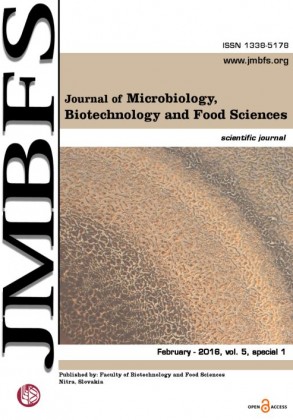ENERGETIC PROFILE OF RABBITS AFTER AMYGDALIN ADMINISTRATION
DOI:
https://doi.org/10.15414/jmbfs.2016.5.special1.50-52Keywords:
Amygdalin, rabbits, glucose, triglycerides, cholesterolAbstract
Amygdalin is a cyanogenic glucoside initially obtained from the seeds of bitter almonds (Prunus dulcis). It is a natural product that owns antitumor activity and has also been used for the treatment of asthma, bronchitis, emphysema, leprosy and diabetes. It is composed of one molecule of benzaldehyde, two molecules of glucose and one molecule of hydrocyanic acid. Cyanide is not cancerocidal as long as glucose is available. The present in vivo study was designed to reveal whether amygdalin is able to cause changes in the energetic profile of rabbit as a biological model. A 12 adult male rabbits were randomly divided into three groups: the control group without any amygdalin administration and two experimental groups receiving daily intramuscular injections (IM) of amygdalin at 0.6 and 3.0 mg/kg b.w. respectively over the period of 28 days. The body weight of each experimental animal was recorded weekly during the whole study. Serum levels of energetic profile (glucose, triglycerides and cholesterol) were determined. Intramuscular application of amygdalin did not affect (P≥0.05) the serum levels of none of selected biochemical parameters significantly. In this in vivo study, no obvious beneficial or negative effects of amygdalin on energetic profile of male rabbits were demonstrated.Downloads
Download data is not yet available.
Downloads
Published
2016-02-08
How to Cite
TuÅ¡imová, E., KováÄik, A., Halenár, M., Zbyňovská, K., Chrastinová, Ľubica, OndruÅ¡ka, ĽubomÃÂr, JurÄÃk, R., Kolesár, E., & Kolesárová, A. (2016). ENERGETIC PROFILE OF RABBITS AFTER AMYGDALIN ADMINISTRATION. Journal of Microbiology, Biotechnology and Food Sciences, 5(special 1), 50–52. https://doi.org/10.15414/jmbfs.2016.5.special1.50-52
Issue
Section
Biotechnology
License
Copyright (c) 2016 Eva TuÅ¡imová, Anton KováÄik, Marek Halenár, KatarÃÂna Zbyňovská, Ľubica Chrastinová, ĽubomÃÂr OndruÅ¡ka, Rastislav JurÄÃk, Eduard Kolesár, Adriana Kolesárová

This work is licensed under a Creative Commons Attribution 4.0 International License.
All papers published in the Journal of Microbiology, Biotechnology and Food Sciences are published under a CC-BY licence (CC-BY 4.0). Published materials can be shared (copy and redistribute the material in any medium or format) and adapted (remix, transform, and build upon the material for any purpose, even commercially) with specifying the author(s).





